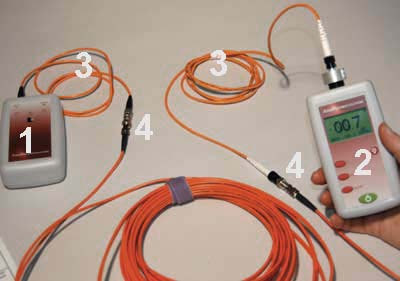The latest optical fibre testing equipment streamlines troubleshooting and diagnostics in telecommunications.
The latest optical fibre testing equipment streamlines troubleshooting and diagnostics in telecommunications.
Blog Article
Discover the Importance of Optical Fibre Screening in Modern Telecommunications
In the realm of modern-day telecoms, the relevance of optical fiber screening can not be overemphasized, as it acts as the backbone for making sure network reliability and efficiency. By executing regular screening procedures, operators can preemptively recognize possible issues such as signal degradation, hence guarding against disturbances that could confirm pricey. Advanced strategies like Optical Time-Domain Reflectometry play a crucial role in this procedure, yet lots of might overlook the more comprehensive ramifications of these practices. What are the certain advantages that routine screening offers, and exactly how might it form the future landscape of telecoms?

Comprehending Optical Fiber Testing
Optical fiber testing is a critical process in telecommunications that makes sure the integrity and efficiency of fiber optic networks. This screening incorporates a series of procedures developed to assess the physical and practical attributes of optical fibers - robotic vision. Trick parameters evaluated include optical power loss, data transfer ability, and fault area, which are necessary for keeping high-quality communication web links
The testing process typically involves using specialized devices such as Optical Time-Domain Reflectometers (OTDR) and Optical Power Meters. OTDRs are utilized to identify and define mistakes, interlaces, and ports within the fiber, while power meters gauge the transmitted light signal stamina to ascertain effectiveness.
Furthermore, screening is conducted at numerous phases, consisting of throughout setup, upkeep, and troubleshooting, to guarantee that the network meets industry standards and operational requirements. Compliance with standards set by organizations like the International Telecommunication Union (ITU) and the Telecommunications Industry Organization (TIA) is critical.
Benefits of Routine Examining
Normal screening of optical fibres returns numerous advantages that considerably improve network integrity and efficiency. One of the main benefits is the early detection of prospective concerns, such as breaks or degradation in the fiber, which can result in pricey downtime if left unaddressed (robotic vision). By identifying these troubles proactively, telecommunications service providers can minimize solution disruptions and guarantee constant connection for their clients
In addition, regular screening assists to maintain the stability of signal top quality. As optical fibers age, their performance can be impacted by elements such as ecological conditions and physical stress. Routine assessments allow for the tracking of signal loss and total transmission effectiveness, guaranteeing that the network operates at optimum levels.
An additional considerable advantage is conformity with market requirements. Normal testing sustains adherence to regulatory needs, thus minimizing legal and economic dangers connected with non-compliance. It improves the general life-span of the fibre facilities by assisting in prompt maintenance and repairs.

Typical Evaluating Techniques
Evaluating optical fibers uses various methods to ensure the honesty and performance of telecoms networks. Among the most common techniques is Optical Time Domain Reflectometry (OTDR), which evaluates the whole length of the fiber by sending out a pulse of light and gauging the representations triggered by flaws or breaks. This technique provides comprehensive info about the area and intensity of mistakes.
An additional common technique is using Optical Power Meters, which measure the quantity of light transferred with the fiber. This strategy helps figure out the loss of signal stamina, making sure that it satisfies industry criteria. In Addition, Visual Fault Locators (VFL) are utilized to determine breaks or serious bends in the fiber by forecasting a noticeable laser light into the cable.
Insertion loss screening is additionally vital, as it evaluates the loss of signal power arising from connections and splices within the network. Furthermore, making use of Polarization Setting Diffusion (PMD) testing assesses the influence of fiber attributes on signal honesty.
Each of these approaches plays a vital duty in preserving the performance and reliability of optical fiber networks, eventually adding to smooth telecommunications operations.
Influence on Network Efficiency
The integrity and efficiency of optical fibre networks directly influence total network performance. In modern telecoms, the efficiency of information transmission relies greatly on the high quality of the optical fibres used. Any degradation in the fiber's condition-- whether as a result of physical damage, contamination, or too much bending-- can bring about enhanced depletion and signal loss, considerably impacting information integrity and rate.
Normal optical fibre screening is important to determine and remedy potential problems before they show up as network failings or slowdowns. Methods such as Optical Time Domain Name Reflectometry (OTDR) and insertion loss testing make it possible for service technicians to measure the efficiency of fibre links properly. These try this site examinations not only examine the physical problem of the fibers however additionally guarantee conformity with sector standards, consequently protecting the network's reliability.
Additionally, a properly maintained optical fibre network adds to minimized functional prices and boosted customer contentment, as end-users experience fewer interruptions and higher data rates. Eventually, the focus on strenuous optical fiber screening practices acts as a foundation for sustaining robust telecommunications framework, making certain that service companies can satisfy the expanding needs for Full Report bandwidth and connectivity in today's electronic age.
Future Patterns in Evaluating
As we look in advance, improvements in modern technology are positioned to improve optical fiber screening in telecoms. The increase of automation and artificial knowledge (AI) is anticipated to boost the performance and precision of screening processes. Automated testing systems can conduct extensive assessments with minimal human intervention, significantly decreasing the capacity for errors and accelerating time-to-deployment.
Additionally, the combination of maker knowing algorithms will enable predictive maintenance, permitting network providers to foresee possible concerns prior to they intensify into failings. This positive method not only improves network reliability but additionally enhances operational prices.
One more emerging trend is the growth of portable testing tools that use real-time analysis - robotic vision. These gadgets will encourage service technicians to carry out on-site diagnostics swiftly, promoting quicker resolutions and improving solution high quality
The growth of 5G networks better requires the evolution of testing methodologies. As transmission capacity needs enhance, typical testing strategies may no much longer are enough. Cutting-edge options such as optical time-domain reflectometry (OTDR) and advanced spectral evaluation will end up being crucial in making sure the integrity and efficiency of high-speed links.

Conclusion
To conclude, optical fibre screening is necessary for guaranteeing the integrity and integrity of modern telecoms networks. Routine screening techniques not just help determine prospective issues such as signal loss original site and mistakes but likewise add to boosted network efficiency and customer fulfillment. As the demand for smooth connection proceeds to expand, the fostering of advanced testing techniques will play a crucial function in preserving top notch network criteria and sustaining the evolving landscape of telecommunications.
Report this page